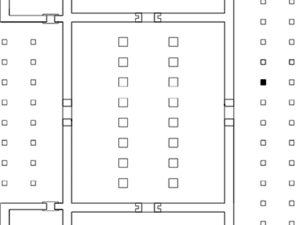Sang-e Siāh, Borāzjānسنگ سیاه، برازجان
Location: Sang-e Siāh was in the Dashtestan region in southern Iran, Bushehr Province.
29°20’18.22″N 51° 9’47.72″E
Map
Historical Period
Achaemenid
History and description
The site of Sang-e Siāh (Black Stone) is located 10 km northwest of Borāzjān, in the vicinity of the village of Jatūt. The archaeological site is about 400 m from the Dālaki River which flows in the south. The building consists of a central, columned hall, 24 x 20 m, with two rows of eight columns (fig. 1). The column bases were made of four square plinths caped with a torus. The columns were probably in wood with gypsum plaster. Four columned porticoes were located on the sides of the central hall, with the eastern portico being larger and having 28 columns. The monumental constructions, situated on private agricultural lands, were removed and destroyed during farming activities in the 1980s. However, some visible remnants remain scattered across gardens and farms.
Archaeological Exploration
The site was first reported by Ali Akbar Sarfaraz in 1971 (Sarfaraz, “Kashf-e kākhi az ahd-e Kurosh-e Kabir,” p. 20. In the winter and spring of 1977, Esmail Yaghmaei excavated the site of Sang-e Siāh (Yaghmaei, “Sang-e Siāh,” pp. 99-108) and dated the remains to the reign of Cyrus II’s predecessors, Cambyses I or Cyrus I (Yaghmaei, Bardak-e Siāh, p. 193). The palatial building at Sang-e Siāh was completely destroyed in recent farming activities (Yaghmaei, Kākh-e Bardak-e Siāh, pp. 194-196).
Bibliography
Sarfaraz, A., “Kashf-e kākhi az ahd-e Kourosh-e Kabir dar sāhel-e Khalij-e Fars,” Bāstanchenāsi va Honar-e Iran, Nos. 7-8, pp. 19-31.
Yaghmaei, E., Kākh-e Bardak-e Siāh. Dashtestān, Borazjan, Tehran, 1397/2018.
Zehbari, Z., “The Borazjan Monuments: A Synthesis of Past and Recent Works,” ARTA 2020.002. http://www.achemenet.com/pdf/arta/ARTA_2020_002_Zehbari.pdf
Author: Ali Mousavi
Originally published: March 30, 2022
Last updated: January 15, 2025


































































































































